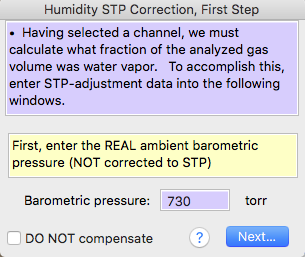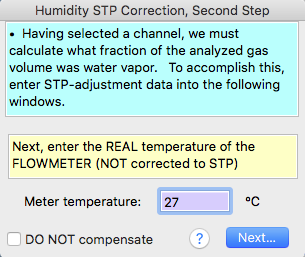
 |
Gas exchange: Sensor humidity compensation
|
SENSOR HUMIDITY COMPENSATION:
Normally, the preferred procedure is to scrub water
vapor from the sampled gas stream before measuring the concentrations of
O2 or CO2.
However, in some respirometry systems it is necessary or desirable to analyze
'wet' gas -- i.e., gas that contains some water vapor. For example,
you might want to make uninterrupted measurements over a very long period.
This introduces a potential problem: any desiccants used to scrub water
vapor may be exhausted before the measurements are completed (and you won't
be able to tell which data were obtained from dry gas and which were not).
By not removing water vapor at all, you can avoid that complication.
In order to accurately compute gas exchange rates from undried gas, it is necessary to remove the dilution effect of water vapor in the gas stream (which slightly reduces the concentration of O2 or CO2 in the gas analyzer). This causes an underestimate (VCO2) or overestimate (VO2) of 'true' gas exchange rates. The resulting error is small if the temperature and relative humidity of the measured gas are low, but increase rapidly as temperature and humidity climb (see the figure in the section on water vapor correction showing the volumetric contribution of water vapor at different temperatures and humidities). Low barometric pressure increases the error still further. You can use several methods for compensating for measurements on wet gas, but for all of them you must provide information of the temperature and water content of the measured gas stream. You can use recorded channels of relative humidity or dew point, or provide a constant value. Similarly, you can use recorded or constant values for temperature. These are selected through a series of windows. Note that some combinations require extensive vapor pressure calculations for each data point, which slows the computation speed.
This selection is necessary because water vapor in the sensor dilutes the concentrations of other gases and affects gas exchange calculations in opposite ways for oxygen and carbon dioxide:
This may seem confusing, but remember than animals consume oxygen (i.e., lowering O2 content of air going to the sensor) but produce CO2 (i.e., raising CO2 content of air going to the sensor). Finally, you can select if you want to store the result in a new channel (if the number of channels is less than the maximum channel count).
The next step is to specify whether sensor gas water content is measured as:
 
If you specified using relative humidity data for sensor compensation, you are next asked for a channel containing humidity sensor temperature data; alternately you can use a constant temperature: FInally, you are asked for the channel containing the humidity data, or you can use a constant humidity:
Once all these data are entered, the software will compensate for temperature differences between the humidity sensor and the flowmeter. |
| Other links: |